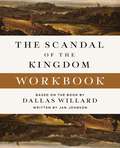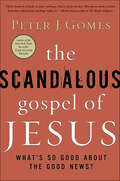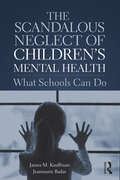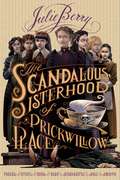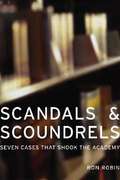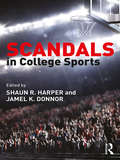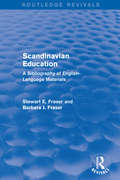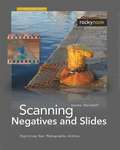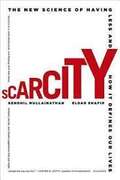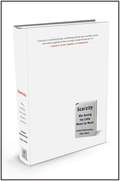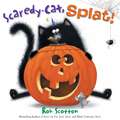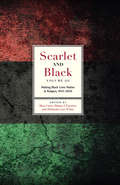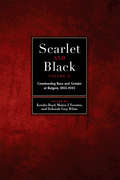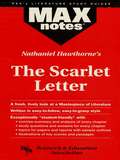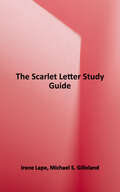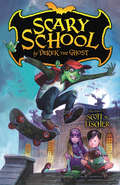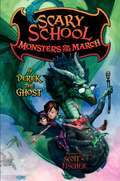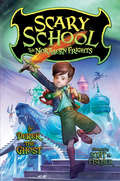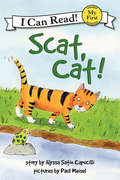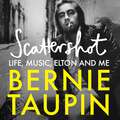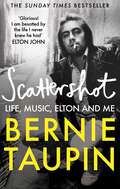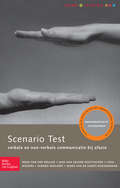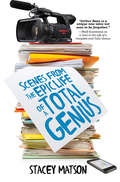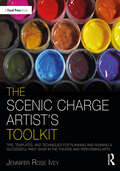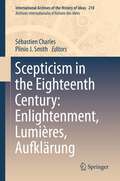- Table View
- List View
The Scandal of the Kingdom Workbook: How the Parables of Jesus Revolutionize Life with God
by Dallas WillardThere is a striking difference between the way that most churches operate today and the way Jesus the conducted his ministry when he was on earth. Most churches today spend their time and resources trying to get people to come into their doors and join their fellowship. But Jesus didn't concern himself with trying to get followers. One time, he even responded to such a request by saying, "Foxes have dens and birds have nests, but the Son of Man has no place to lay his head" (Matthew 8:12). The implication to the person making the request was clear: Do you really want to be my follower and lead that kind of life?Instead, what we find in the Gospels is that the message Jesus taught—and in fact the sole message of the New Testament—was the nature and availability of the kingdom of God. It was now accessible to all people, both Jews and Gentiles alike. Jesus revealed much of these scandalous truths about God's kingdom through parables. Yet while these parables constitute some of his best-known teachings, they are also some of the least understood. Even the disciples weren't always sure what they meant. Perhaps this is why they asked Jesus, "Why do you speak to the people in parables" (Matthew 13:10). Jesus responded by saying, "Because the knowledge of the secrets of the kingdom of heaven has been given to you, not to them" (verse 11). Jesus knew that while the kingdom of God was available to everyone, not everyone would have the desire to go through the work to "ask, seek, knock" and "receive" the truths that had come to bring (see Matthew 7:7–8).The Scandal of the Kingdom Workbook, which accompanies the book of the same name, presents carefully curated new material from the late Dallas Willard to help readers understand the heart of Jesus' key parables, why Jesus chose story to communicate life's deepest truths, and how these stories are still revolutionary (and even shocking) in showing us how to live out God's kingdom on earth today. With the rich insights and biblical scholarship common to all of Willard's works, this guide will help readers:Become more passionate about living the gospel in the full scope of Jesus' vision for themBetter share their faith with those who have become disillusioned with ChristianityUnlock the excitement of living in the upside-down kingdom of GodThe Scandal of the Kingdom Workbook is for anyone who:Wants to explore Jesus' teachings but are confused about what his parables meanLoves Dallas Willard's classic works such as The Divine Conspiracy and Life Without LackEnjoys deep teachings about spiritual formation from authors such as John Mark Comer, Richard Foster, and Eugene PetersonWants to share the gospel just as Jesus did during his ministry on earthThe truths of God's kingdom are available to us. Yet like the disciples, we must recognize that questioning, contemplating, and savoring the meaning of Jesus' stories are an important part of the journey.
The Scandalous Gospel of Jesus: What's So Good About the Good News?
by Peter J. Gomes“Gomes is an iconoclast, and his book is an alternately eloquent and folksy attack on everybody who is sure of the right answer.” —NewsweekHow the Church Domesticated JesusWith his unique blend of eloquence and insight, the esteemed Harvard minister Peter J. Gomes invites us to hear anew the radical nature of Jesus’ message of hope and change. Using examples from ancient times as well as from modern pop culture, The Scandalous Gospel of Jesus shows us why the good news is every bit as relevant today as when it was first preached.“Of the hundreds of books on Jesus’ teachings, this is by far the best. Mincing no words, it drives home how radical Jesus’ teachings really are.” —Huston Smith, author of The World’s Religions“An incisive original . . . [Gomes is] a born storyteller.” —Publishers Weekly, starred review
The Scandalous Neglect of Children’s Mental Health: What Schools Can Do
by James M. Kauffman Jeanmarie BadarThe Scandalous Neglect of Children’s Mental Health: What Schools Can Do makes the case that children with mental health needs are under-identified and under-served by schools and other agencies. After reading this brief but powerful book, you will better understand the nature of children’s mental health needs and the need for expanded services for children in schools and communities. The risks and benefits of treatment, especially early intervention, are discussed and guidelines for action by teachers, parents, and others are provided. The sad fact is that many people do not understand that most young people with mental health needs never receive any treatment of any kind and most of those who receive any treatment at all receive those services only in schools.
The Scandalous Sisterhood of Prickwillow Place
by Julie BerryThe students of St. Etheldreda's School for Girls face a bothersome dilemma. Their irascible headmistress, Mrs. Plackett, and her surly brother, Mr. Godding, have been most inconveniently poisoned at Sunday dinner. Now the school will almost certainly be closed and the girls sent home--unless these seven very proper young ladies can hide the murders and convince their neighbors that nothing is wrong.
Scandals and Scoundrels: Seven Cases That Shook the Academy
by Ron RobinRon Robin takes an intriguing look at the shifting nature of academic and public discourse in this incisive consideration of recent academic scandals. Scandals and Scoundrels makes the case that, contrary to popular imagery, we're not living in particularly deviant times and there is no fundamental flaw permeating a decadent academy. Instead, Robin argues, latter-day scandals are media events, tailored for the melodramatic and sensationalist formats of mass mediation.
Scandals in College Sports: Legal, Ethical, And Policy Case Studies
by Shaun R. Harper Jamel K. DonnorThis timely book highlights the impact that sports have on institutions of higher education and guides college leaders and educators in informed discussions of policy and practice. Scandals in College Sports includes 21 classic and contemporary case studies and ethical dilemmas showcasing challenges that threatened the integrity and credibility of intercollegiate sports programs at a range of institutional types across the country. Cases cover NCAA policy violations and ethical dilemmas involving student-athletes, coaches, and other stakeholders, including scandals of academic misconduct, illegal recruiting practices, sexual assault, inappropriate sexual relationships, hazing, concussions, and point shaving. Each chapter author explores the details of the specific case, presents the dilemma in a broader sociocultural context, and ultimately offers an alternative ending to help guide future practice.
Scandinavian Education: A Bibliography of english- language materials (Routledge Revivals)
by Stewart. E Fraser Barbara. J FraserThis title was first published in 1973. Education in the Scandinavian countries has commanded significant international attention over the past decade. Initiatives taken to promote comprehensive educational planning, the democratization of educational opportunity, curricular and structural renewal, university reform, innovation in adult education, and an international perspective in instruction at every level are but some of the developments that educators throughout the world have followed with interest. Those interested in education in the Nordic societies, Stewart and Barbara Fraser's annotated bibliography of English-language materials on Scandinavian education will provide an important new reservoir of source materials. The bibliography is conveniently cross-referenced and organized into specialized educational categories
Scanning Negatives and Slides: Digitizing Your Photographic Archive, 2nd Edition
by Sascha Steinhoff<p>Many photographers have either moved into digital photography exclusively or use both analog and digital media in their work. In either case, there is sure to be an archive of slides and negatives that cannot be directly integrated into the new digital workflow, nor can it be archived in a digital format. Increasingly, photographers are trying to bridge this gap with the use of high-performance film scanners. <br/><br/>\nIn this 2nd edition, you will learn how to achieve the best possible digital image from a negative or a slide, and how to build a workflow to make this process efficient, repeatable, and reliable. The author uses Nikon's film scanners, but all steps can easily be accomplished while using a different scanner. The most common software tools for scanning (SilverFast, VueScan, NikonScan) are not only covered extensively in the book, but trial versions are also provided on a DVD, which also contains other useful tools for image editing, as well as numerous sample scans.</p>
Scarcity: The New Science Of Having Less And How It Defines Our Lives
by Sendhil Mullainathan Eldar ShafirIn the blockbuster tradition of Freakonomics, a Harvard economist and a Princeton psychology professor team up to offer a surprising and empowering new way to look at everyday life, presenting a paradigm-challenging examination of how scarcity - and our flawed responses to it - shapes our lives, our society, and our culture. Why do successful people get things done at the last minute? Why does poverty persist? Why do organizations get stuck firefighting? Why do the lonely find it hard to make friends? These questions seem unconnected, yet Sendhil Mullainathan and Eldar Shafir show that they are all are examples of a mindset produced by scarcity. Drawing on cutting-edge research from behavioral science and economics, Mullainathan and Shafir show that scarcity creates a similar psychology for everyone struggling to manage with less than they need. Busy people fail to manage their time efficiently for the same reasons the poor and those maxed out on credit cards fail to manage their money. The dynamics of scarcity reveal why dieters find it hard to resist temptation, why students and busy executives mismanage their time, and why sugarcane farmers are smarter after harvest than before. Once we start thinking in terms of scarcity and the strategies it imposes, the problems of modern life come into sharper focus.
Scarcity: Why Having Too Little Means So Much
by Sendhil Mullainathan Eldar ShafirA surprising and intriguing examination of how scarcity-and our flawed responses to it-shapes our lives, our society, and our culture. Why do successful people get things done at the last minute? Why does poverty persist? Why do organizations get stuck firefighting? Why do the lonely find it hard to make friends? These questions seem unconnected, yet Sendhil Mullainathan and Eldar Shafir show that they are all examples of a mind-set produced by scarcity. Drawing on cutting-edge research from behavioral science and economics, Mullainathan and Shafir show that scarcity creates a similar psychology for everyone struggling to manage with less than they need. Busy people fail to manage their time efficiently for the same reasons the poor and those maxed out on credit cards fail to manage their money. The dynamics of scarcity reveal why dieters find it hard to resist temptation, why students and busy executives mismanage their time, and why sugarcane farmers are smarter after harvest than before. Once we start thinking in terms of scarcity and the strategies it imposes, the problems of modern life come into sharper focus. Mullainathan and Shafir discuss how scarcity affects our daily lives, recounting anecdotes of their own foibles and making surprising connections that bring this research alive. Their book provides a new way of understanding why the poor stay poor and the busy stay busy, and it reveals not only how scarcity leads us astray but also how individuals and organizations can better manage scarcity for greater satisfaction and success.
Scaredy-Cat, Splat! (Splat the Cat)
by Rob ScottonIt's Halloween and Splat is determined to be the scariest cat in the class. Unfortunately he's just too much of a scaredy-cat. He's afraid of a little spider, and everyone says his costume looks more silly than scary. And when the teacher tells a ghost story in the dark, Splat gets so frightened that he tips over his jack-o-lantern. But when the lights go back on, the entire class is scared silly by a small, black furry creature with a big pumpkin head. Whoooo could it be?
Scarlet and Black, Volume Three: Making Black Lives Matter at Rutgers, 1945-2020
by Roberto C. Orozco Carie Rael Brooke A. Thomas Ian Gavigan Pamela N. Walker Joseph Williams Kaisha Esty Whitney Fields Beatrice J. Adams Jesse Bayker Kenneth Morrissey Edward White Tracey Johnson Joseph Kaplan Meagan Wierda Lynda DexheimerThe 250th anniversary of the founding of Rutgers University is a perfect moment for the Rutgers community to reconcile its past, and acknowledge its role in the enslavement and debasement of African Americans and the disfranchisement and elimination of Native American people and culture. Scarlet and Black, Volume Three, concludes this groundbreaking documentation of the history of Rutgers’s connection to slavery, which was neither casual nor accidental—nor unusual. Like most early American colleges, Rutgers depended on slaves to build its campuses and serve its students and faculty; it depended on the sale of black people to fund its very existence. This final of three volumes concludes the work of the Committee on Enslaved and Disenfranchised Population in Rutgers History. This latest volume includes essays about Black and Puerto Rican students' experiences; the development of the Black Unity League; the Conklin Hall takeover; the divestment movement against South African apartheid; anti-racism struggles during the 1990s; and the Don Imus controversy and the 2007 Scarlet Knights women's basketball team. To learn more about the work of the Committee on Enslaved and Disenfranchised Population in Rutgers History, visit the project's website at http://scarletandblack.rutgers.edu.
Scarlet and Black, Volume Two: Constructing Race and Gender at Rutgers, 1865-1945
by Beatrice J. Adams Shauni Armstead Miya Carey Tracey Johnson Brenann Sutter Pamela N. Walker Meagan Wierda Caitlin Reed Wiesner Shari Cunningham Eri Kitada Jerrad P Pacatte Joseph WilliamsThe 250th anniversary of the founding of Rutgers University is a perfect moment for the Rutgers community to reconcile its past, and acknowledge its role in the enslavement and debasement of African Americans and the disfranchisement and elimination of Native American people and culture. Scarlet and Black, Volume 2, continues to document the history of Rutgers’s connection to slavery, which was neither casual nor accidental—nor unusual. Like most early American colleges, Rutgers depended on slaves to build its campuses and serve its students and faculty; it depended on the sale of black people to fund its very existence. This second of a planned three volumes continues the work of the Committee on Enslaved and Disenfranchised Population in Rutgers History. This latest volume includes: an introduction to the period studied (from the end of the Civil War through WWII) by Deborah Gray White; a study of the first black students at Rutgers and New Brunswick Theological Seminary; an analysis of African-American life in the City of New Brunswick during the period; and profiles of the earliest black women to matriculate at Douglass College. To learn more about the work of the Committee on Enslaved and Disenfranchised Population in Rutgers History, visit the project's website at http://scarletandblack.rutgers.edu
The Scarlet Letter (MAXNotes Literature Guides)
by Michael PetrusREA's MAXnotes for Nathaniel Hawthorne's The Scarlet Letter The MAXnotes provides a comprehensive summary and analysis of The Scarlet Letter and a biography of Nathaniel Hawthorne. Places the events of the novel in historical context and discusses each chapter in detail. Includes study questions and answers along with topics for papers and sample outlines.
The Scarlet Letter Study Guide
by Irene Lape Michael S. GillelandThrough Nathaniel Hawthorne's timeless tale of sin, guilt, vengeance, and redemption, students will learn: Background Information: Do some research to learn more about the early history of the Massachusetts Bay Colony, Romanticism, and Transcendentalism. Author Biography Vocabulary words used throughout the novel, utilizing a variety of activities to stimulate retention and growth. Literary Techniques: Grammar and parts of speech, root words, foreshadowing, imagery, synonym, personification, compare & contrast, in context. Moral Lessons and Character Values: Keeping secrets, lying, shame, penance, and martyrdom, judging others, correction and pride, vengeance, confession, subjective morality, reconciliation with God. Activities and Writing Assignments: Pre-reading analysis papers on civil government, biblical view of sin, and biblical response to people. Brook Farm research. Point-of-view summary essay. Puritanism research paper. Analyze patterns in the novel. Suggestions for Further Reading: We include an in-depth reading list of more books by the same author(s) and other books that tie in with, or are similar to, The Scarlet Letter. All of the unit lessons are written from a Christian worldview! - Large 8.5x11 printed workbook format is convenient to read and easy on the eyes - Every question has plenty of whitespace for student's answers - Encourages neat and clean handwriting practice - Easily transports without the need for a laptop or other expensive equipment - Provides a permanent record of the student's work - Convenient, removable answer key included for the teacher! - Study guides do not contain the text of the story, play, poems, or book.- Recommended for grades 9-12. - Setting: Massachusetts 1640s - Genre: American literature, Historical literature
Scary School
by Derek The Ghost Scott M. FischerYou think your school's scary? Get a load of these teachers: Ms. Fang, an 850-year-old vampire Dr. Dragonbreath, who just might eat you before recess Mr. Snakeskin-science class is so much more fun when it's taught by someone who's half zombie Mrs. T-break the rules and spend your detention with a hungry Tyrannosaurus rex! Plus Gargoyles, goblins, and Frankenstein's monster on the loose The world's most frighteningly delicious school lunch And The narrator's an eleven-year-old ghost! Join Charles "New Kid" Nukid as he makes some very Scary friends-including Petunia, Johnny, and Peter the Wolf-and figures out that Scary School can be just as funny as it is spooky!
Scary School #2: Monsters on the March
by Scott M. Fischer Derek The GhostAs winners of last year's Ghoul Games, the students of Scary School are off to Monster Forest. School may be scary, but the forest has a few frights of its own, including: Bearodactyls-so terrifying we can't even show you pictures of them Princess Zogette, the Monster King's toad-faced daughter, who falls for Charles Nukid . . . hard Captain Pigbeard, fearsome leader of the Monster-Pirates and Princess Zogette's fiancÉ (well, former fiancÉ, thanks to Charles) And when Zogette follows Charles to Scary School, the Monster King and Captain Pigbeard raise their armies and chase after her. But the monsters have no idea who-or what-they're dealing with. In this clever, funny sequel to the frighteningly hilarious Scary School, Charles, Penny Possum, Dr. Dragonbreath, and all the students and teachers prove that scary monsters are no match for Scary School!
Scary School #3: The Northern Frights
by Derek The GhostCharles Nukid and his friends--including new student Lattie, a tough ninja girl--take on their biggest challenge yet in this frighteningly funny addition to the Scary School series. When theyre chosen to attend Scream Academy as exchange students, theyll have to face: Rolf Meltington--the principal of Scream Academy and the abominable snowmanPolter-bears--part poltergeist, part polar bear . . . totally frighteningThe Headless Horseman--dont lose your head in his classBut theres something even scarier than going to school with yetis, ogres, and trolls: the Ice Dragon. As an ancient prophecy comes to pass, Charles finds himself destined to battle the monstrous Ice Dragon in order to save both Scream Academy and Scary School from destruction.
Scat, Cat! (My First I Can Read)
by Alyssa Satin CapucilliA small striped cat finds his way homeNo one wants the small striped cat who is lost. “Scat, cat!” says the dog, the bird, the barber, the baker, the bus driver, the duck, the frog, the goose, the owl, the bat, and even the skunk.So the cat walks and walks until he finds a little house where there is a little boy that does not say, “Scat, cat!” In an ending twist, the cat discovers he is home. Young readers will learn the names of animals and occupations as well as useful vocabulary in this sweet and simple text.This My First I Can Read Book is perfect for shared reading with toddlers and very young children. Basic language, word repetition, and whimsical illustrations make this book just right for the emergent reader.
Scattershot: Life, Music, Elton and Me
by Bernie Taupin'This is the most glorious of books. I am besotted by the life I never knew he had.' -Elton John'Orgasmic. Every page of Scattershot is a delight, a joy, a name-dropper fan's delight. Divine. I couldn't put it down.' -Pete Townshend'In Bernie Taupin's miraculous memoir Scattershot you'll meet legends, cowboys, geniuses, unforgettable faces in the night, shady purveyors of outrageous fortune, warriors of the heart, and most of all, Taupin himself. Hilarious and so emotionally true, Scattershot is like a letter from a cherished friend. You'll want to keep it close, so you can read it again and again.' -Cameron Crowe'Touching. Charming. Humble. Witty. And exquisitely written. Taupin's words need no musical accompaniment. They sing with a poets voice.' -Gary Oldman'Eloquent and inspiring, Scattershot is a freewheeling memoir that is as warm and evocative as Bernie Taupin's most memorable lyrics. A born storyteller, Taupin gives us the life of an artist whose outlook was shaped by a rare but fascinating blend of lifelong innocence and endless intellectual curiosity.' -Robert Hilburn, author of Johnny Cash: The Life"I loved writing, I loved chronicling life and every moment I was cogent, sober, or blitzed, I was forever feeding off my surroundings, making copious notes as ammunition for future compositions. . . . The thing is good, bad or indifferent I never stopped writing, it was as addictive as any drug."This is the memoir music fans have been waiting for. Half of one of the greatest creative partnerships in popular music, Bernie Taupin is the man who wrote the lyrics for Elton John, who conceived the ideas that spawned countless hits, and sold millions and millions of records. Together, they were a duo, a unit, an immovable object. Their extraordinary, half-century-and-counting creative relationship has been chronicled in biopics (like 2019's Rocketman) and even John's own autobiography, Me. But Taupin, a famously private person, has kept his own account of their adventures close to his chest, until now.Written with honesty and candour, Scatterhot allows the reader to witness events unfolding from Taupin's singular perspective, sometimes front and center, sometimes from the edge, yet always described vibrantly, with an infectious energy that only a vivid songwriter's prose could offer. From his childhood in the East Midlands of England whose imagination was sparked and forever informed by the distinctly American mythopoetics of country music and cowboys, to the glittering, star-studded fishbowl of '70s and '80s Beverly Hills, Scattershot is simultaneously a Tom Jones-like picaresque journey across a landscape of unforgettable characters, as well as a striking, first-hand account of a creative era like no other and one man's experience at the core of it.An exciting, multi-decade whirlwind, Scattershot whizzes around the world as we ride shotgun with Bernie on his extraordinary life. We visit New York with him and Elton on the cusp of global fame. We spend time with him in Australia almost in residency at an infamous rock 'n' roll hotel in an endless blizzard of drugs. And we spend late, late night hours with John Lennon, with Bob Marley, and hanging with Frank Sinatra. And beyond the world of popular music, we witness memorable encounters with writers like Graham Greene, painters like Andy Warhol and Salvador Dali, and scores of notable misfits, miscreants, eccentrics, and geniuses, known and unknown. Even if they're not famous in their own right, they are stars on the page, and we discover how they inspired the indelible lyrics to songs such as "Tiny Dancer," "Candle in the Wind," "Bennie and The Jets," and so many more.Unique and utterly compelling, Scattershot will transport the reader across the decades and around the globe, along the way meeting some of the greatest creative minds of the 20th century, and in
Scattershot: Life, Music, Elton and Me
by Bernie Taupin'This is the most glorious of books. I am besotted by the life I never knew he had.' -Elton John'Orgasmic. Every page of Scattershot is a delight, a joy, a name-dropper fan's delight. Divine. I couldn't put it down.' -Pete Townshend'In Bernie Taupin's miraculous memoir Scattershot you'll meet legends, cowboys, geniuses, unforgettable faces in the night, shady purveyors of outrageous fortune, warriors of the heart, and most of all, Taupin himself. Hilarious and so emotionally true, Scattershot is like a letter from a cherished friend. You'll want to keep it close, so you can read it again and again.' -Cameron Crowe'Touching. Charming. Humble. Witty. And exquisitely written. Taupin's words need no musical accompaniment. They sing with a poets voice.' -Gary Oldman'Eloquent and inspiring, Scattershot is a freewheeling memoir that is as warm and evocative as Bernie Taupin's most memorable lyrics. A born storyteller, Taupin gives us the life of an artist whose outlook was shaped by a rare but fascinating blend of lifelong innocence and endless intellectual curiosity.' -Robert Hilburn, author of Johnny Cash: The LifeThis is the memoir music fans have been waiting for. Half of one of the greatest creative partnerships in popular music, Bernie Taupin is the man who wrote the lyrics for Elton John, who conceived the ideas that spawned countless hits, and sold millions and millions of records. Together, they were a duo, a unit, an immovable object. Their extraordinary, half-century-and-counting creative relationship has been chronicled in biopics (like 2019's Rocketman) and even John's own autobiography, Me. But Taupin, a famously private person, has kept his own account of their adventures close to his chest, until now.Written with honesty and candour, Scatterhot allows the reader to witness events unfolding from Taupin's singular perspective, sometimes front and center, sometimes from the edge, yet always described vibrantly, with an infectious energy that only a vivid songwriter's prose could offer. From his childhood in the East Midlands of England whose imagination was sparked and forever informed by the distinctly American mythopoetics of country music and cowboys, to the glittering, star-studded fishbowl of '70s and '80s Beverly Hills, Scattershot is simultaneously a Tom Jones-like picaresque journey across a landscape of unforgettable characters, as well as a striking, first-hand account of a creative era like no other and one man's experience at the core of it.An exciting, multi-decade whirlwind, Scattershot whizzes around the world as we ride shotgun with Bernie on his extraordinary life. We visit New York with him and Elton on the cusp of global fame. We spend time with him in Australia almost in residency at an infamous rock 'n' roll hotel in an endless blizzard of drugs. And we spend late, late night hours with John Lennon, with Bob Marley, and hanging with Frank Sinatra. And beyond the world of popular music, we witness memorable encounters with writers like Graham Greene, painters like Andy Warhol and Salvador Dali, and scores of notable misfits, miscreants, eccentrics, and geniuses, known and unknown. Even if they're not famous in their own right, they are stars on the page, and we discover how they inspired the indelible lyrics to songs such as "Tiny Dancer," "Candle in the Wind," "Bennie and The Jets," and so many more.Unique and utterly compelling, Scattershot will transport the reader across the decades and around the globe, along the way meeting some of the greatest creative minds of the 20th century, and into the vivid imaginings of one of music's most legendary lyricists.
Scenario Test handleiding: Verbale en non-verbale communicatie bij afasie
by I. van der Meulen J. van Gelder-Houthuizen J. Wiegers S. Wielaert M. Sandt-KoendermanMeet: verbale en non–verbale communicatie vaardigheden van afasiepatienten.Leeftijdsbereik: volwassen afasiepatienten.Afname en scoringsduur: 30–40 minutenToepasbaar in: o.a. revalidatiecentra, verpleeghuizen, logopedische praktijkKwalificatieniveau: 1 (o.a. logopedisten en klinisch linguisten).Doel van de testDe Scenario Test meet de communicatieve vaardigheden van afasiepatienten in alle beschikbare communicatiekanalen. De test richt zich dus niet alleen op de mogelijkheid tot informatieoverdracht via het spreken, maar onderzoekt ook de mogelijkheden tot informatieoverdracht via alternatieve communicatiekanalen. Hieronder vallen de non–verbale communicatiekanalen (bijvoorbeeld mimiek, gebaren of tekenen), schrijven of schriftelijke ondersteuning en het gebruik van communicatiehulpmiddelen (bijvoorbeeld het Gespreksboek of een elektronisch communicatieapparaat).De Scenario Test is in eerste instantie bedoeld voor afname bij mensen met een matige tot ernstige afasie, bij wie de therapie gericht is op het inschakelen van alternatieve communicatiekanalen. Voor het succes van dergelijke therapie is het van belang om inzicht te hebben in de vraag of iemand in staat is tot het gebruik van alternatieve communicatie.Therapie gericht op alternatieve communicatie wordt vooral gegeven aan afasiepatienten bij wie het spreken niet of nauwelijks meer mogelijk is, zoals bij mensen met een globale of Broca afasie. De Scenario Test kan echter ook informatief zijn bij mensen met een lichtere afasie om na te gaan of zij hun verbale communicatie ondersteunen met alternatieve strategieen. Bij Wernicke patienten met spraakdwang en een slecht ziekte–inzicht is de test vaak niet afneembaar. Bijzonder aan de Scenario Test is dat er interactie is tussen de afasiepatient en de testleider.Communicatie is immers interactief en succesvolle communicatie bij personen die niet of nauwelijks meer kunnen spreken is sterk afhankelijk van de houding van de communicatiepartner. In de Scenario Test is de rol van de communicatiepartner daarom structureel opgenomen. Met de Scenario Test wordt systematisch nagegaan of iemand een bepaalde vorm van (alternatieve) communicatie beheerst, en of hij hier zelfstandig gebruik van maakt, of met hulp van een communicatiepartner. De Scenario Test biedt zo aanknopingspunten voor therapie gericht op het inzetten van alternatieve communicatieve kanalen en stelt daarnaast het effect van dergelijke therapie vast.ToepassingDiagnostiek: meet de verbale– en alternatieve communicatieve vaardigheden van afasiepatienten en de mate waarin patienten hiervoor afhankelijk zijn van hun communicatiepartner.Therapiekeuze: bepaalt welke vorm van alternatieve communicatietherapie voor een patient het meest geschikt is.Evaluatie: meet het effect van de gegeven therapie.Advisering: voor het opstellen van communicatieadviezen voor de omgeving van de patient.Materiaal Scenario Test complete set (handleiding, testmateriaal, scoreformulieren)Scenario Test scoreformulierenScenario Test handleiding
Scenes from the Epic Life of a Total Genius
by Stacey MatsonLights! Camera! Action! Arthur Bean is ready to have the best year any eighth grader has ever had. The awesome zombie movie he's writing with BFF Robbie Zack is definitely going to be a blockbuster. He even has a girlfriend. Yes, that's right, a GIRLFRIEND! With everything lined up so nicely, he's sure his teachers will start to appreciate his true genius this year. Except for the little problem of the movie camera Arthur and Robbie "borrowed" to film their upcoming blockbuster movie. And then Arthur's girlfriend gets jealous of his friendship with Kennedy. And there's the actual co-writing, producing, and directing of their film...Drama is definitely on the menu for this year. Arthur would just prefer it stay confined to his script.
The Scenic Charge Artist's Toolkit: Tips, Templates, and Techniques for Planning and Running a Successful Paint Shop in the Theatre and Performing Arts (The Focal Press Toolkit Series)
by Jennifer Rose IveyThe Scenic Charge Artist’s Toolkit is a comprehensive guide to managing a theatrical paint shop. This book introduces the many different options available to a scenic charge artist, as well as the fundamental expectations and responsibilities of planning and running a shop. From the pre-production organization, budgeting, sampling, and sealing, to practical lessons in efficiency and shop maintenance, this text provides options to organize a paint shop no matter the size of the shop, show, or company. Filled with templates for labor and time estimation; tips on leadership and collaboration; techniques for painting and planning textures efficiently; and sustainable practices in health, safety, and wellness, this book provides guidance and practices to successfully manage the inevitable changes in theatre planning and production. It also offers tips and reference material on employment options, gaining employment, and excelling in this profession. Written for early career scenic artists in theatre and students of Scenic Art courses, The Scenic Charge Artist’s Toolkit fills in the gaps of knowledge for scenic artists in the budgeting, planning, and running of shops at summer stock, educational institutions, or freelance working environments. The text includes access to additional online resources such as extended interviews, downloadable informational posters and templates for budgeting and organizing, and videos walking through the use of templates and the budgeting process.
Scepticism in the Eighteenth Century: Enlightenment, Lumières, Aufklärung
by Sébastien Charles Plínio J. SmithThe Age of Enlightenment has often been portrayed as a dogmatic period on account of the veritable worship of reason and progress that characterized Eighteenth Century thinkers. Even today the philosophes are considered to have been completely dominated in their thinking by an optimism that leads to dogmatism and ultimately rationalism. However, on closer inspection, such a conception seems untenable, not only after careful study of the impact of scepticism on numerous intellectual domains in the period, but also as a result of a better understanding of the character of the Enlightenment. As Giorgio Tonelli has rightly observed: "the Enlightenment was indeed the Age of Reason but one of the main tasks assigned to reason in that age was to set its own boundaries." Thus, given the growing number of works devoted to the scepticism of Enlightenment thinkers, historians of philosophy have become increasingly aware of the role played by scepticism in the Eighteenth Century, even in those places once thought to be most given to dogmatism, especially Germany. Nevertheless, the deficiencies of current studies of Enlightenment scepticism are undeniable. In taking up this question in particular, the present volume, which is entirely devoted to the scepticism of the Enlightenment in both its historical and geographical dimensions, seeks to provide readers with a revaluation of the alleged decline of scepticism. At the same time it attempts to resituate the Pyrrhonian heritage within its larger context and to recapture the fundamental issues at stake. The aim is to construct an alternative conception of Enlightenment philosophy, by means of philosophical modernity itself, whose initial stages can be found herein.
